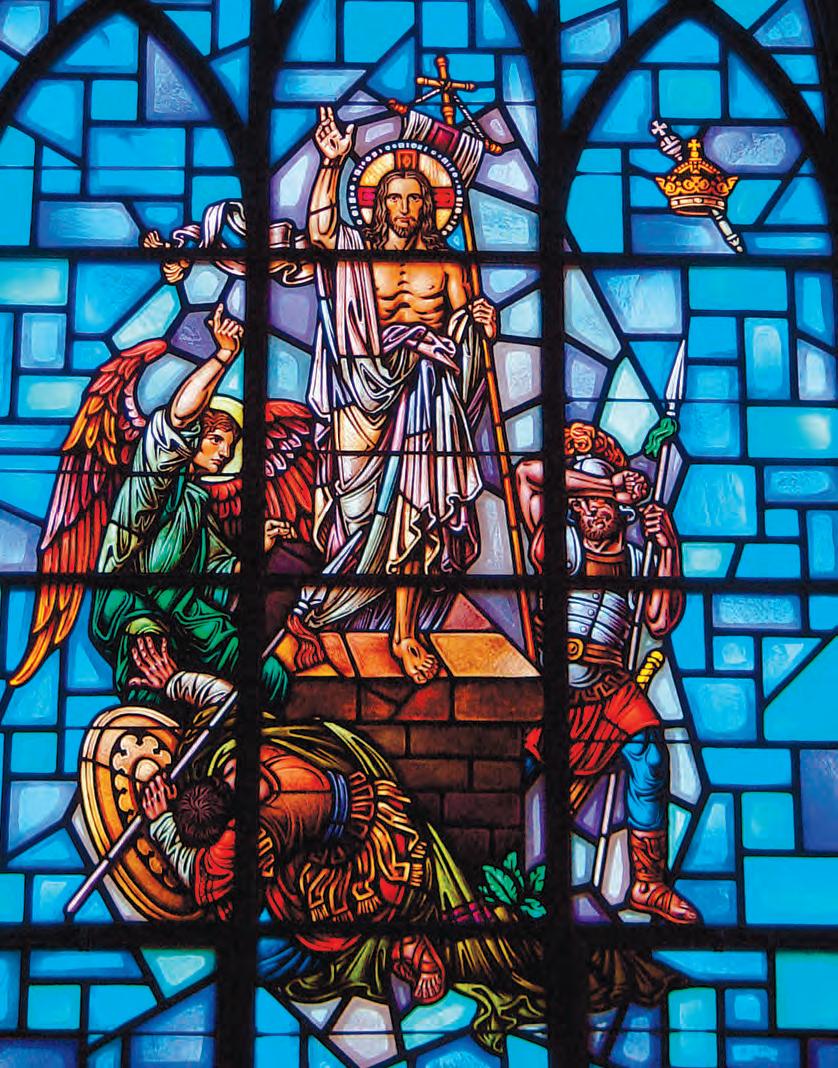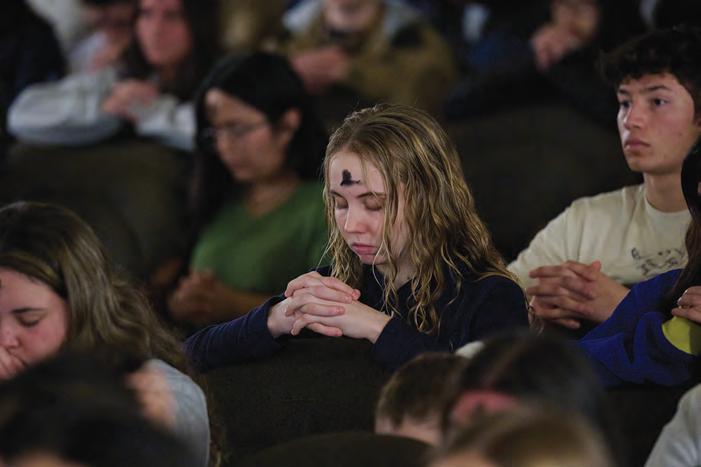Embracing the boundless joy of
 BY PAUL SENZ OSV News
BY PAUL SENZ OSV News
The Resurrection of Jesus Christ is at the heart of the Christian faith. This is the point at which God defeated death and reconciled the world to himself, forging a new and eternal covenant with his people. The Resurrection is so important that the early Christians quickly began to commemorate it every week, on Sunday. Of course, it is celebrated in a special way each year at Easter.
When Jesus prophesied his own suffering and death, his apostles refused to accept it; it was unthinkable for them. Imagine their horror when the man they thought was the Messiah was hung upon a Cross to die, slowly and painfully. Then, imagine their joy when three days later: an empty tomb! The Lord walking among them once again!
Easter is a time of pure and boundless joy. The Easter season lasts 50 days, from Easter Sunday until Pentecost. The joy that comes from the Resurrection cannot be contained in a single day.
The long tradition of the Church has passed down to us numerous ways to cultivate Easter joy in the weeks and months following Easter Sunday.
One way of cultivating Easter joy that the Church provides is to celebrate the Resurrection of Jesus Christ by receiving him – body, blood, soul and divinity – in the Eucharist. Every Sunday is set aside as a special celebration of the Resurrection, a commemoration of Christ’s victory over death; but we must bear in mind that every celebration of the Mass makes present the sacrifice of Christ on the Cross, and celebrates his glorious Resurrection. In that sense, there is no better time than Easter
Continued on 10
March 2024 THE MONITOR MAGAZINE 9 In Focus
The stained glass window of the Resurrected Christ is found in St. Paul Church, Princeton. File photo

Easter joy
Continued from 9
to attend daily Mass whenever possible, making it a priority. More and more parishes offer evening Mass during the week to allow working professionals to attend. Seeking out opportunities like this is one way to cultivate Easter joy and live in the Resurrection.
The word “Eucharist” is derived from a Greek term meaning “thanksgiving.” And the Easter season is perfectly suited to help in forming habits of gratitude. One way we can help ourselves recognize and truly internalize just what happened at the Resurrection would be to diligently work to grow in gratitude in our own lives. All of us are given countless blessings by God, and far more often than not they are blessings we do not even recognize or acknowledge. It takes effort, but it is important to try to recognize these blessings and be grateful.
We can start by reflecting on the Resurrection itself. What a tremen-



dous blessing, a gift that can never be adequately reciprocated: God became incarnate, offered himself as a sacrifice for the sins of mankind, and defeated death once and for all. We should give thanks to God every day for this blessing and grow in a general sense of gratitude for the blessings God bestows upon us.
Another way Catholics can cultivate Easter joy during this season is by putting ourselves in the shoes of the apostles, and walking with Jesus during the period after the Resurrection. The Stations of the Cross are one of the most widely known and practiced devotions among Catholics; this method of walking with Jesus, prayerfully joining him in his own steps, helps Catholics to understand Christ’s Passion and Death. Following Easter, we should consider walking with Jesus in the same way in regards to his earthly life between the Resurrection and the Ascension.
The Gospels and the Acts of the Apostles recount these days of Jesus’ life, at some points in great detail. Prayerfully reflecting on these passages can lead to great insights, and foster a deeper connection with this relatively littlethought-of period.
There are stories of the profound and boundless joy experienced by the disciples of Jesus when they encountered him risen. Even Thomas, the eponymous doubter, upon realizing that Jesus had truly risen and was standing before him, showing his wounds, was so overcome that he could but say, “My Lord and my God!” This is the joy we all should cultivate in ourselves and help foster in our community.
The Easter season is also a wonderful opportunity to extend Lenten obser-
vances – or add more. If one’s Lenten observance was to pray 15 minutes a day, why stop at Easter? This should be a habit formed in Lent and continued with joy throughout Easter and beyond. This may even be a time to add things like regular adoration of the Blessed Sacrament; or praying the Rosary; or joining the ordained, religious and many lay men and women all over the world in the praying of the Liturgy of the Hours.
This is not a penitential season, however. Jesus said, “Can the wedding guests mourn as long as the bridegroom is with them? The days will come when the bridegroom is taken away from them, and then they will fast” (Mt 9:15). The bridegroom is with us! He is risen! This is not a time for fasting, but for celebration and joy. And we can foster that joy by uniting ourselves with Jesus.
If there is one thing that can be learned from the Resurrection of Jesus Christ, it is that death is no longer the final answer. In willingly sacrificing himself for the sake of all humanity – and every single individual person specifically – and dying on the Cross, only to be gloriously resurrected on the third day, our Lord overcame death once and for all. The gates of heaven have been thrown open, and God extends a hand of welcoming to each and every one of us. We need simply to accept the forgiveness he offers, and be welcomed into his loving embrace.
In the Easter season, it seems impossible not to be reminded of the Prodigal Son. There is perhaps no other story, apart from Christ’s passion and Resurrection, that better communicates to us the love and boundless forgiveness of God. The father in the story tells us so much about how God feels about his own children,
In Focus 10 THE MONITOR MAGAZINE March 2024
ARE A FEW SIMPLE WAYS TO HELP LIVE OUT THE EIGHT WEEKS OF EASTER: Be joyful
Celebrate as a family
Pick up a spiritual book
Maintain spiritual devotions
Follow faith-filled sources on social media
Give to charity Turn to the Holy Spirit in prayer Befriend a saint
Easter HERE
Shown is a 2023 Living Stations presentation in Villa Victoria Academy, West Trenton.
Facebook photo

and this is even truer after the Resurrection: My son who was once lost is now found! How can we contain our joy at this forgiveness and reconciliation? We should not contain it! Death no longer holds sway over us; we have each been given a glorious opportunity to accept God’s unending love and forgiveness. There is no greater gift.
We see this tale again and again throughout salvation history: God forms a covenant with his people, only to have his people betray that covenant and do their best to sever the bond. And yet, time and again, God remains steadfast – unfailingly steadfast. There is always reconciliation on the horizon, always an opportunity for God’s people to accept his offer of forgiveness and be reconciled to him. Recognizing this is one incredibly profound way to celebrate the Easter season.
The theme of God’s forgiveness is particularly close to the heart of our Holy Father. In his first Sunday Angelus address, only a few days after his election to the papacy, Pope Francis famously said, “God’s face is that of a merciful father who is always patient. Have you thought about God’s patience, the patience that he has with each of us? That is his mercy. He always has patience, patience with us, he understands us, he waits for us, he does not tire of forgiving us if we are able to return to him with a contrite heart. ... The Lord never tires of forgiving. It is we who tire of asking forgiveness.”
God has provided ultimate and endless forgiveness to us through the death and Resurrection of Jesus.
Jesus Christ is risen from the dead. It may seem impossible that the second person of the Trinity became incarnate and dwelt among us; it may seem unthinkable that this incarnate second person of the Trinity suffered and died the most ignominious and humiliating death imaginable; and it may seem utterly absurd that, after all that, he rose again, glorified.
But it is true, all of it. For God so loved the world that he gave his only son, so that everyone who believes in him might not perish but might have eternal life (Jn 3:16). Because of this, we are filled with joy – Christ is risen! Let us cultivate that joy in ourselves and everywhere.
Paul Senz writes from Oregon.
Holy Week






Pope Francis set to
observe full
schedule for Holy Week, Easter
BY JUSTIN MCLELLAN Catholic News Service
VATICAN CITY • Pope Francis’ calendar for Holy Week and Easter is just as full as in previous years despite a mild illness which has caused him to cancel meetings in the days leading up to the release of his liturgical calendar for March.
The Pope canceled meetings Feb. 24 and Feb. 26 due to “flu-like symptoms,” the Vatican said. Although he held his general audience Feb. 28, an aide read Pope Francis’ prepared remarks, and the Vatican said he briefly visited a Rome hospital after the audience for medical tests.
The Pope is scheduled preside over all the major liturgical celebrations of Holy Week.
As is customary when first publishing the Pope’s calendar for Holy Week, the Vatican did not provide the time or place for his celebration of the Mass of the Lord’s Supper on Holy Thursday,

March 28. Pope Francis has made it a tradition to celebrate the Mass and foot-washing ritual at a prison or detention center, refugee center or rehabilitation facility; last year he did so at a prison for minors in Rome.
Here is the schedule of papal liturgical ceremonies and events for March released by the Vatican Feb. 29:
March 24, Palm Sunday, morning Mass in St. Peter’s Square.
March 28, Holy Thursday, morning Chrism Mass in St. Peter’s Basilica.
March 29, Good Friday, afternoon liturgy of the Lord’s Passion in St. Peter’s Basilica.
March 29, Way of the Cross at night at Rome’s Colosseum.
March 30, Easter Vigil Mass in the evening in St. Peter’s Basilica.
March 31, Easter morning Mass in St. Peter’s Square, followed at noon by the Pope’s blessing “urbi et orbi” (to the city and the world).
Lent
March 2024 THE MONITOR MAGAZINE 11
Easter
Pope Francis gathers with a group of religious sisters for a group photo at the end of his weekly general audience in the Paul VI Audience Hall at the Vatican Feb. 28, 2024. Despite some health challenges, the Holy Father will carry a full schedule through Holy Week and Easter. CNS photo/Vatican Media

Flavorful Fridays: The beauty of the uncooked meal
BY EMMALEE ITALIA Contributing Editor
As much as I love cooking, there are some days when putting something in the oven just seems to be the last insurmountable hurdle in the day.
It could be deep in the summer doldrums when the house is already too hot to think about heated meal prep. It could be after a long week of too many obligations on the calendar. Or it could be during a Lenten week when I’m trying to balance everyday tasks with attending the occasional evening spiritual exercise at my parish.
It’s times like these when my inner Mary and Martha seem to compete for my affections. Yes, like Mary, I need to spend time with my Lord and listen to what he will teach me. But, inner-Martha argues, my family still needs to eat, and there’s only one of me. Sure, they could survive on some cereal or crackers from the pantry – but as the family cook, I feel a strong pull to provide a balanced, nutritious dinner as often as I can.
That’s when I remind myself to think outside the baking dish. A filling and nutritious meal doesn’t have to be complicated or take a long time to prepare. A little chopping and stirring, and voila – supper is served. And there’s still time left to devote to God in personal prayer or a church-sponsored event.
This recipe for Spring Rolls I found online more than a decade ago, and I find myself changing the ingredients depending on my mood. But the method remains the same – chop the
FRESH SPRING ROLLS
from www.celiac.com
1 pkg. broccoli slaw or Asian slaw
2 pkgs. rice flour spring roll wrappers
1 can (or 2 cups fresh) bean sprouts
32 cooked shrimp, tails removed, diced
2 Tablespoons soy sauce

ingredients, sauté a few of them briefly to soften, mix and wrap. Then chill – not just in the refrigerator, but also mentally and physically. And make some time for Jesus.
EmmaLee Italia is a contributing editor to The Monitor and sole proprietor of Flavors by EmmaLee LLC. For more information email chef@flavorsbyemmalee.com.


1 teaspoon salt
1/2 teaspoon sugar
1/2 teaspoon pepper
2 Tablespoons cooking oil (olive or avocado)
2 teaspoons sesame seed oil
S auté slaw and fresh bean sprouts approx. 2-4 minutes in olive or avocado oil. (For crunchier texture of raw ingredients, you can skip this step.)
Add salt, pepper, sugar and sesame oil. Remove from heat. Add diced shrimp. Drain mixture in colander.
Fill large bowl with hot tap water. Spread kitchen towel on counter. Construct rolls one at a time: soak 1 rice paper wrapper in water 15-20 seconds, then lay flat on towel. Place 1/3-1/2 cup filling in center of wrapper, fold up bottom of wrapper, fold in sides, then roll toward the top to seal the roll.
Serve chilled, or sauté first in oil to crisp outside. Serve with dipping sauce. Refrigerate leftovers up to 1 week (do not freeze).
DIPPING SAUCE for Spring Rolls or Egg Rolls from www.food.com
1 1/2 Tablespoons soy sauce
3/4 cup water
2 teaspoons cornstarch
1/3 cup seasoned rice vinegar
1/4 cup brown sugar
2 teaspoons white sugar
1 Tablespoon fresh ginger (or 1 teaspoon ground ginger)
2 cloves garlic, minced
1/2 teaspoon sesame oil
Combine all ingredients in small saucepan and heat just until sugar is dissolved. Serve with rolls; refrigerate leftover sauce up to 1 week or freeze for up to 1 month.
12 THE MONITOR MAGAZINE March 2024 In Focus
Freepik image


In this sacred season, let the voices of the faithful ring out
BY LAURA KELLY FANUCCI OSV News
The first thing I noticed about our parish was the music. Everyone sang.
From the moment the opening hymn began, the sanctuary was filled with a robust chorus. I looked around and couldn’t believe my eyes (or ears) – adults, children, women and men were all singing at full voice.
I grew up in a typical Catholic church where the congregation mostly listened to the choir or cantor, so I came to assume the same whenever I’d visit a new parish. You might find beautiful instrumental music or an exceptional choir, but rarely would the people in the pews respond with more than a mumbling “Amen.”
But now our parish has changed my mind.
It’s a foretaste of heaven to look around Mass and witness the full participation of the people of God. Turns out, the wider Church agrees. In the Constitution on the Sacred Liturgy issued by the Second Vatican Council, we find robust encouragement for active participation: “Religious singing by the people is to be intelligently fostered so that in devotions and sacred exercises, as also during liturgical services, the voices of the faithful may ring out according to the norms and requirements of the rubrics” (Sacrosanctum Concilium, 118).
What’s more, this vocal participation in the liturgy becomes a means for grace: “And the people reply to God both by song and prayer … when the Church prays or sings or acts, the faith of those taking part is nourished and their minds





are raised to God, so that they may offer Him their rational service and more abundantly receive his grace” (Sacrosanctum Concilium, 33).
All this makes me wonder: are we teaching younger generations of Catholics how to sing?
Few sports fans would refuse to stand and sing for the national anthem or “Take Me Out To The Ball Game.” Many drivers belt out their favorite tunes on the radio in the car. But do we bring the same enthusiastic participation to Mass?
Of course, context matters. Worship is meant to be reverent, not raucous. But full and active participation in the liturgy means not just silent respect but singing, too. The cantor or choir are meant to be the leaders we follow, not the soloists we watch. We are not spectators but participants in these sacred mysteries.
My high school choir director often quoted St. Augustine that “singing is praying twice.” Sacred song sinks into our bones, giving God glory. We don’t need to be professional singers or have perfect pitch, only to raise our voices in praise and thanksgiving together.
If your own singing has lagged as an adult, what a perfect practice to add to your Lenten observance: singing more at Mass. Remember that your children, grandchildren and all young people in

the pews are watching. What are we teaching children by the way we sing?
You might start by singing more at home. Growing up, my family added a sung grace after the traditional “Bless us, O Lord” prayer. Today my own family sings a short hymn before dinner to match the liturgical season. Each night I get to hear voices, old and young, warble “Lord, Who Throughout These Forty Days” and remember how Christ came for all of us, from toddlers to teenagers to tired adults – and everyone in between.
Music makes us human. From the first rhythms of our mother’s heartbeat in the womb, we grow attuned to the world through song: lullabies, childhood ABCs, birthday celebrations, and holiday favorites. But if we stop singing in worship –out of insecurity, boredom, habit or sheer laziness – we miss what full participation in the liturgy means: the grace it brings us and the glory it gives to God.
In its ancient roots, the word “enthusiasm” means to be inspired or inhabited by God. This Lent, let us bring our enthusiasm to Mass and pray together in song, that we might all be filled with God’s Holy Spirit, from generation to generation.
Laura Kelly Fanucci is an author, speaker, and founder of Mothering Spirit, an online gathering place on parenting and spirituality.
Lent Holy Week Easter March 2024 THE MONITOR MAGAZINE 13
Parishioners join in song in St. Luke Church, Toms River. Hal Brown photo


Solemn

On Ash Wednesday Feb. 14, the faithful of the Diocese of Trenton responded to the Lenten call to “repent and believe the Gospel.” From receiving blessed ashes, to spending time with Bishop David M. O’Connell, C.M., during his Lenten visits throughout the Diocese, Catholics of all ages responded to the call to make this season one of holiness and transformation.


p Bishop O’Connell speaks to the congregation during his homily for the Mass he celebrated in Princeton University Chapel for Catholic students of the Aquinas Institute and their families. Mike Ehrmann photo
Students in St. Mary School, Middletown, watch as blessed palms from the previous year’s Palm Sunday are burned to create ashes for Ash Wednesday.
Facebook photo
In Focus 14 THE MONITOR MAGAZINE March 2024







Bishop David M. O’Connell, C.M., places ashes on the forehead of an Ash Wednesday participant in St. Mary of the Assumption Cathedral, Trenton. Hal Brown photo


During an Ash Wednesday service in St. Mary of the Assumption Cathedral, Trenton, a baby is given ashes by Msgr. Joseph L. Roldan, Cathedral rector. Hal Brown photo

Lent Holy Week Easter March 2024 THE MONITOR MAGAZINE 15 � To view more photos of Lenten events, visit TrentonMonitor.com > More Galleries
Students in Monmouth University, West Long Branch, pray after receiving ashes during a Mass celebrated by Bishop O’Connell. Mike Ehrmann photo
‘He has been raised!’
 JA Message from BISHOP DAVID M. O’CONNELL, C.M.
JA Message from BISHOP DAVID M. O’CONNELL, C.M.

esus of Nazareth lived most of his life in obscurity without much notoriety or attention paid to him. The Gospels tell us about his birth in Bethlehem and, later, about his appearance in the temple at age 12. Other than that, the Gospels are largely silent about Jesus of Nazareth until he appears before John the Baptist in the Jordan and begins his public ministry around age 30.
Those hidden years of Jesus’ life leave everything to the imagination and to speculation. And while that is true of Jesus of Nazareth, the Jesus of history, it is not true of Jesus the Messiah, the Christ of faith.
A thousand years or more of Old Testament writings and traditions kept the Messiah before the Jewish people’s minds and in their hopes and expectations before the “Word became flesh and dwelt among us.” They are not two different persons, no. They are one and the same. Jesus the Messiah, the Christ of faith is eternal but chose to live in a specific, identifiable, historic time period, hence the title, “Jesus of history.”
It is the New Testament, especially the Gospels, that connect all that was planned and foretold about the Messiah with Jesus of Nazareth. And the events of Holy Week have made that abundantly clear.
The week began with Jesus’ tri-
umphant entrance into Jerusalem and continued with his celebration of Passover with the Twelve Apostles. The week ended with his brutal crucifixion and death. The Church’s liturgies for Palm Sunday, Holy Thursday and Good Friday painted the picture in a most dramatic way and led us to Jesus’ tomb.
Although Jesus was an “unknown” for most of his life, he certainly attracted enough attention in his last three years of his earthly existence to lift people’s hopes that the Messiah had come, and the Messiah was he! But when he died in a most humiliating way, the hopes of his followers that he was the Messiah were dashed … But that was not the end of the story, as we know.
John’s Gospel tells us that when the women came to the tomb in which Jesus was buried, the stone was already rolled back; his body was not there; the tomb was empty. “He has been raised; he is not here” they were told by the angel. Jesus of Nazareth is the Christ of faith, the Messiah – everything that had been said and predicted about him had been fulfilled, had come true.
The Lord Jesus Christ has risen from the dead. That is what we Christians celebrate at Easter and that is what joins us with baptized Catholics throughout the world.
For all of us who believe in the Lord
Jesus Christ, Easter is the heart of our faith – its life, its breath, its everything. There is no more significant human expression than faith in Jesus’ Resurrection. He didn’t just die and come back to life. He was not revived or resuscitated. Jesus’ Resurrection is about new life, transformed life, a completely different order of existence. He rose from the dead leaving death behind him. The tomb is empty. This is about glory and triumph.
Easter is the heart of our faith ...
The tomb is empty.

“Christ once raised from the dead shall never die again; death has no more power over him.” And the source of our Easter joy is that he offers the same triumph and glory to us who believe in him. That is the meaning of our Baptism when we say we die in Christ only to rise in him, new, changed, different, filled with grace and light and life.
Easter is that moment in human history when the world was changed forever: changed by an obscure Jesus of Nazareth who lived and died but who rose to new life, Jesus Christ the Messiah of God, the Christ of our faith! Amen! Alleluia! Happy Easter!
March 2024 THE MONITOR MAGAZINE 7 From the Bishop
Shutterstock image
 BY PAUL SENZ OSV News
BY PAUL SENZ OSV News


























 JA Message from BISHOP DAVID M. O’CONNELL, C.M.
JA Message from BISHOP DAVID M. O’CONNELL, C.M.

